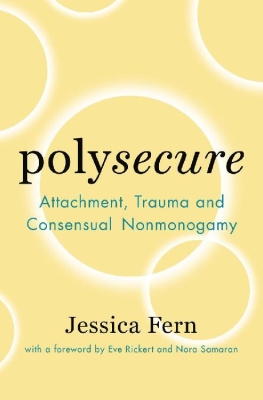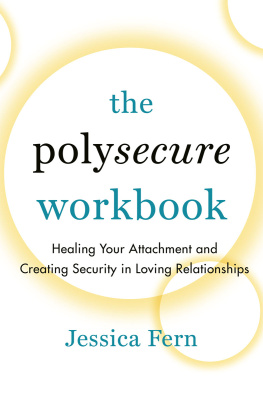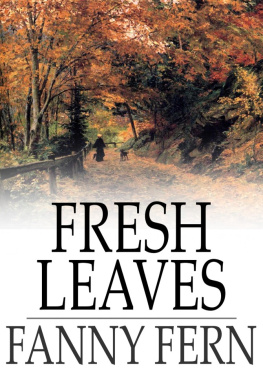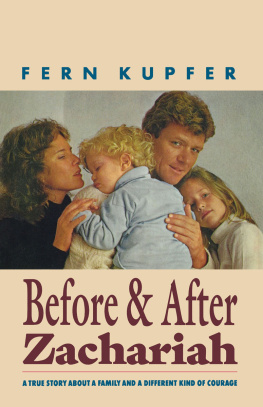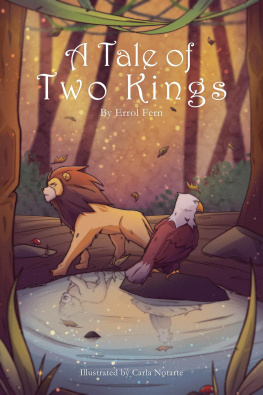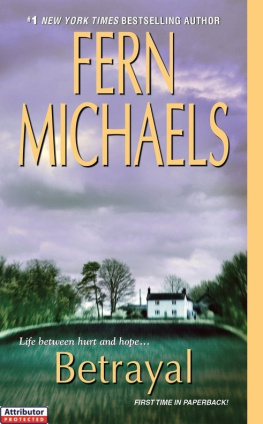Jessica Fern - Polysecure
Here you can read online Jessica Fern - Polysecure full text of the book (entire story) in english for free. Download pdf and epub, get meaning, cover and reviews about this ebook. year: 2020, publisher: Thorntree Press, genre: Home and family. Description of the work, (preface) as well as reviews are available. Best literature library LitArk.com created for fans of good reading and offers a wide selection of genres:
Romance novel
Science fiction
Adventure
Detective
Science
History
Home and family
Prose
Art
Politics
Computer
Non-fiction
Religion
Business
Children
Humor
Choose a favorite category and find really read worthwhile books. Enjoy immersion in the world of imagination, feel the emotions of the characters or learn something new for yourself, make an fascinating discovery.
- Book:Polysecure
- Author:
- Publisher:Thorntree Press
- Genre:
- Year:2020
- Rating:4 / 5
- Favourites:Add to favourites
- Your mark:
- 80
- 1
- 2
- 3
- 4
- 5
Polysecure: summary, description and annotation
We offer to read an annotation, description, summary or preface (depends on what the author of the book "Polysecure" wrote himself). If you haven't found the necessary information about the book — write in the comments, we will try to find it.
Polysecure — read online for free the complete book (whole text) full work
Below is the text of the book, divided by pages. System saving the place of the last page read, allows you to conveniently read the book "Polysecure" online for free, without having to search again every time where you left off. Put a bookmark, and you can go to the page where you finished reading at any time.
Font size:
Interval:
Bookmark:
PRAISE FORPOLYSECURE
Anyone even considering nonmonogamy would benefit from reading Polysecure. Jessica Fern does an excellent job of not only explaining attachment theory and applying it to nonmonogamy but also offering real steps readers can take and skills they can hone to help create the secure, satisfying relationships they want.
JoEllen Notte, sex educator and author of The Monster Under the Bed: Sex, Depression, and the Conversations We Arent Having
This is required reading for people in open relationships and should be used as a textbook for every therapist who works with people in polyamorous relationships.
Kathy Labriola, counselor, nurse and author of The Polyamory Breakup Book, The Jealousy Workbook and Love in Abundance
Polysecure gives people a way to understand how they may be recreating old patterns by bringing their own childhood attachment styles into their adult relationships. And even more importantly, it offers concrete skills for how to use this knowledge to create healthier, more satisfying and secure relationship dynamics.
Max Rivers, intimacy coach and author of Loving Conflict: How Conflict Is Really Your Relationship Trying to Go Deeper
An extremely helpful addition to the literature on consensual nonmonogamy, and the first self-help book to focus on applying attachment theory to nonmonogamous relationships.
Dr. Meg-John Barker, author of Rewriting the Rules: An Anti Self-Help Guide to Love, Sex and Relationships
I whole-heartedly recommend this book to anyone interested in self-acceptance and self-mastery, as well as their own emotional well-being as they build loving, sustainable, healthy multiple relationships.
Kitty Chambliss, relationship coach and author of Jealousy Survival Guide: How to Feel Safe, Happy and Secure in an Open Relationship
A great read for both therapists who serve people in consensually nonmonogamous relationships and laypeople who are interested in what makes for secure attachments in such relationships.
Dr. Elisabeth Sheff, author of The Polyamorists Next Door, Stories from the Polycule, When Someone You Love is Polyamorous and Children in Polyamorous Families


Polysecure
Attachment, Trauma and Consensual Nonmonogamy
Copyright 2020 by Jessica Fern. All rights reserved. No part of this book may be used or reproduced in any manner whatsoever without written permission from the publisher except in the case of brief quotations in critical articles and reviews.
Thorntree Press, LLC
P.O. Box 301231
Portland, OR 97294
Thorntree Presss activities take place on traditional and ancestral lands of the Coast Salish people, including the Chinook, Musqueam, Squamish and Tsleil-Waututh nations.
Cover design by Brianna Harden
Interior design by Jeff Werner
Substantive editing by Andrea Zanin
Copy-editing by Hazel Boydell
Proofreading by Heather van der Hoop
Library of Congress Cataloging-in-Publication Data
Names: Fern, Jessica, author.
Title: Polysecure : attachment, trauma and consensual nonmonogamy / by Jessica Fern.
Description: [Portland] : [Thorntree Press], [2020] | Includes bibliographical references and index.
Identifiers: LCCN 2020009992 (print) | LCCN 2020009993 (ebook) | ISBN 9781944934989 (paperback) | ISBN 9781952125003 (kindle edition) | ISBN 9781944934996 (epub) | ISBN 9781952125010 (pdf)
Subjects: LCSH: Nonmonogamous relationships--Psychological aspects. | Attachment behavior.
Classification: LCC HQ980 .F47 2020 (print) | LCC HQ980 (ebook) | DDC 306.84/23--dc23
LC record available at https://lccn.loc.gov/2020009992
LC ebook record available at https://lccn.loc.gov/2020009993
Digital edition v1.0
In loving dedication to Chris Kaminskas (19612009) and my madrina, Maria Pusz (19472014).
You were the safe havens and secure bases that I owe my resiliency to.
The literature on polyamory has come a long way since The Ethical Slut and Polyamory: The New Love Without Limits were first published in 1997. Both books broke new ground and offered a new identity and community for nonmonogamous people who had previously struggled in isolation. But these books were written from the perspectives of specific subcultures, and they didnt (couldnt!) deal with the full range of issues confronted by the newly polyamorous.
Options began to proliferate in the late 2000s, with books like Opening Up and many lesser-known titles. These offered a wider range of practical advice, but as the title Opening Up suggests, this wave of poly practice presumed the centrality of a primary couple and popularized a hierarchical model in which primary partners were to have rights and safety that secondary or casual partners were not granted to the same degree. Early polyamorous media representation through shows like Polyamorous: Married and Dating fiercely reinforced this view.
This was the kind of polyamory I was introduced to when I first began exploring in the early 2000s. The hierarchical relationship structures that were the norm in the online circles I frequented (and nearly all media representation of polyamory) kept some of the feeling of security offered by monogamy by protecting attachment needs, and often masking potential attachment disruptions, for those who were in so-called primary relationships. At the same time, they did a dismal job of honouring the attachment needs of partners who were considered secondary: those outside a primary, usually presumed to be nesting, couple, whose bond was presumed to be more valid or worthy of protection than the others opened up to.
But some people were making noise. In 2003 the publication of A Proposed Secondarys Bill of Rights caused a stir in online polyamorous circles, and provided secondary partners with an important tool to advocate for their needs. Andie Nordgren published The Short Instructional Manifesto for Relationship Anarchy in 2006, questioning the need for relational hierarchies, and by the early 2010s, an increasing number of popular bloggersmany building on Nordgrens workwere pushing for recognition of a wider range of relationship styles, and in particular, of the needs of secondary partners.
Then, in 2014, my co-author and I published More Than Two, attempting to distill the last decades worth of debate into an instructional manual that promised a non-hierarchical, more egalitarian way of thinking about polyamorous relationships.
When More Than Two encouraged polyamorous people to sweep away the external supporting structures of both monogamy and polyamorous hierarchy, though, what it offered in exchange fell short. It placed the onus of building security almost entirely on the individual who felt insecure. Despite the many people who were helped by the book, this inappropriate focus caused harm, and over time, I grew to understand there was something missing in our frameworkI just didnt have the words for what.
It was Noras blog, where in 2016 she proposed that The Opposite of Rape Culture Is Nurturance Culture, that began to help me find words for what had been missing from More ThanTwo. I reached out to her on Twitter to talk about our work.
Next pageFont size:
Interval:
Bookmark:
Similar books «Polysecure»
Look at similar books to Polysecure. We have selected literature similar in name and meaning in the hope of providing readers with more options to find new, interesting, not yet read works.
Discussion, reviews of the book Polysecure and just readers' own opinions. Leave your comments, write what you think about the work, its meaning or the main characters. Specify what exactly you liked and what you didn't like, and why you think so.

